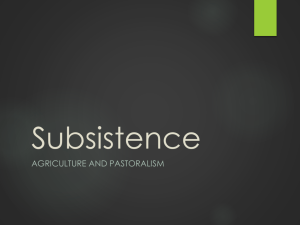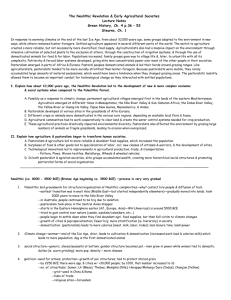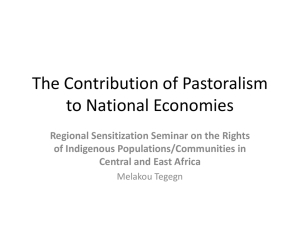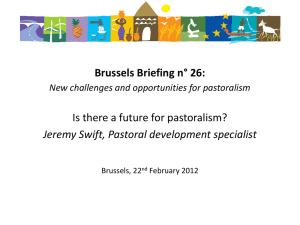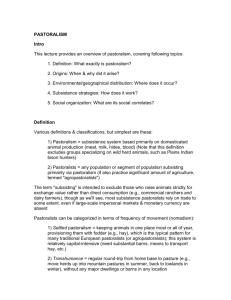Following the herd: why pastoralism needs better media coverage
advertisement
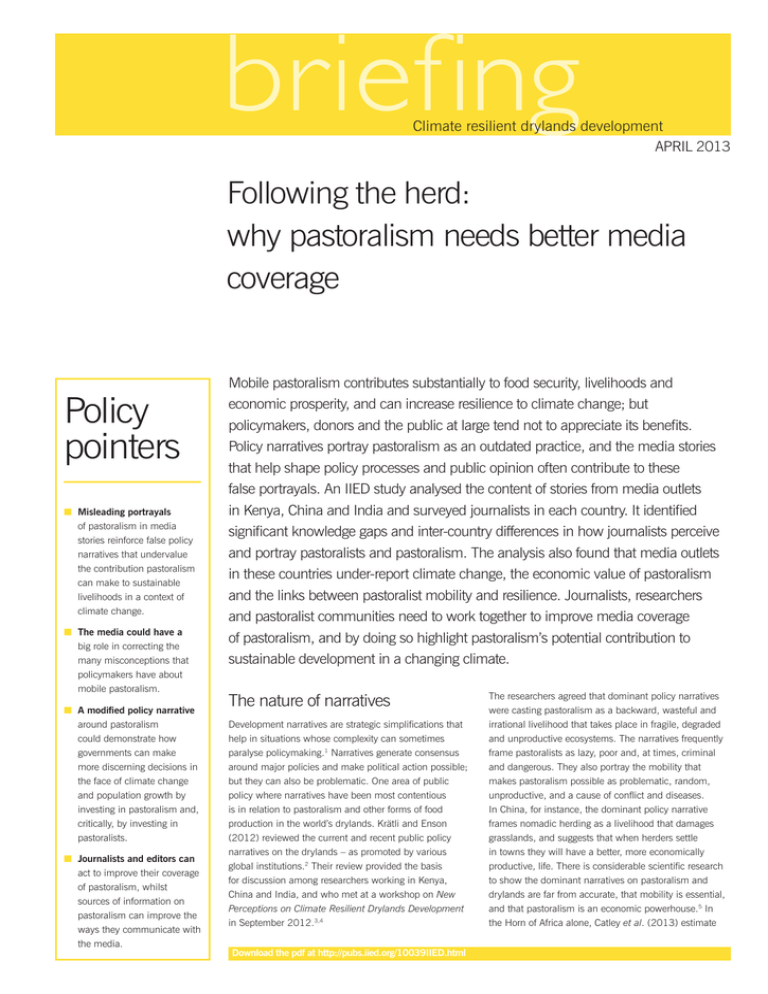
Climate resilient drylands development april 2013 Following the herd: why pastoralism needs better media coverage Policy pointers n M isleading portrayals of pastoralism in media stories reinforce false policy narratives that undervalue the contribution pastoralism can make to sustainable livelihoods in a context of climate change. n T he media could have a big role in correcting the many misconceptions that policymakers have about mobile pastoralism. n A modified policy narrative around pastoralism could demonstrate how governments can make more discerning decisions in the face of climate change and population growth by investing in pastoralism and, critically, by investing in pastoralists. n J ournalists and editors can act to improve their coverage of pastoralism, whilst sources of information on pastoralism can improve the ways they communicate with the media. Mobile pastoralism contributes substantially to food security, livelihoods and economic prosperity, and can increase resilience to climate change; but policymakers, donors and the public at large tend not to appreciate its benefits. Policy narratives portray pastoralism as an outdated practice, and the media stories that help shape policy processes and public opinion often contribute to these false portrayals. An IIED study analysed the content of stories from media outlets in Kenya, China and India and surveyed journalists in each country. It identified significant knowledge gaps and inter-country differences in how journalists perceive and portray pastoralists and pastoralism. The analysis also found that media outlets in these countries under-report climate change, the economic value of pastoralism and the links between pastoralist mobility and resilience. Journalists, researchers and pastoralist communities need to work together to improve media coverage of pastoralism, and by doing so highlight pastoralism’s potential contribution to sustainable development in a changing climate. The nature of narratives Development narratives are strategic simplifications that help in situations whose complexity can sometimes paralyse policymaking.1 Narratives generate consensus around major policies and make political action possible; but they can also be problematic. One area of public policy where narratives have been most contentious is in relation to pastoralism and other forms of food production in the world’s drylands. Krätli and Enson (2012) reviewed the current and recent public policy narratives on the drylands – as promoted by various global institutions.2 Their review provided the basis for discussion among researchers working in Kenya, China and India, and who met at a workshop on New Perceptions on Climate Resilient Drylands Development in September 2012.3,4 Download the pdf at http://pubs.iied.org/10039IIED.html The researchers agreed that dominant policy narratives were casting pastoralism as a backward, wasteful and irrational livelihood that takes place in fragile, degraded and unproductive ecosystems. The narratives frequently frame pastoralists as lazy, poor and, at times, criminal and dangerous. They also portray the mobility that makes pastoralism possible as problematic, random, unproductive, and a cause of conflict and diseases. In China, for instance, the dominant policy narrative frames nomadic herding as a livelihood that damages grasslands, and suggests that when herders settle in towns they will have a better, more economically productive, life. There is considerable scientific research to show the dominant narratives on pastoralism and drylands are far from accurate, that mobility is essential, and that pastoralism is an economic powerhouse.5 In the Horn of Africa alone, Catley et al. (2013) estimate the informal livestock trade to be worth more than US$1 billion each year.6 As part of a larger project aimed at influencing policy narratives around pastoralism, IIED examined the role of the media in reinforcing these dominant narratives and asked how journalistic coverage of the sector could improve.7 The objectives were to understand how journalists portray pastoralists and pastoralism; who speaks for and about pastoralists in the media; and in what contexts the media reports on pastoralism. The content of 100 English language stories from Kenya, 50 from India and 20 from China – most of which were published between 2000 and 2012 – was analysed. In addition, 119 journalists (42 Kenyan, 61 Indian and 16 Chinese) completed an online survey. Following the herd: why pastoralism needs better media coverage What’s the story? In Kenya pastoralists tended to feature only in the ‘bad news’ stories, with 93 per cent of the stories analysed in the IIED study referring to conflict or drought. A 2006 article in The Nation encapsulated the general narrative: “Banditry, robberies, infiltration of small arms, poaching in the region’s game reserves and national parks and frequent outbreak of livestock diseases are now being attributed to the uncontrolled movement of pastoralists and their animals.” Among stories of conflict, 51 per cent presented pastoralists as the cause of the problems, but only 5.7 per cent suggested that pastoralists might be the victims of the actions, or inactions, of others (e.g. farmers or government policies). Of the 28 per cent of articles that reported efforts to evict or move pastoralists, only one-fifth described where the pastoralists might go – and in every case it was back to where they had come from, back to the problems they left behind. In 22 per cent of articles pastoralists were referred to as “invaders” or as having “invaded” land. Positive stories of pastoralists achieving, contributing or leading are extremely rare, and almost half of all stories depicted pastoralists as poor and vulnerable. For Kenyan newspaper readers this persistent narrative must be depressingly familiar. It illustrates a failure of government to tackle the causes of conflict, but it also reveals a failure of journalism to explore why this is the case. The Kenyan media stories made virtually no mention of specific government policies, and only a small proportion reported initiatives that could improve the lives of pastoralists, reduce conflict, or promote sustainable development. By contrast, in China, pastoralists tended to feature as ‘good news’ stories. The media narrative around pastoralism includes many stories about herders who have settled in towns and are largely happy with the change. These stories highlighted government investments in housing and infrastructure that improved the wellbeing of poor communities. They often quoted pastoralists describing how they have gained materially since abandoning their nomadic lifestyle. Although some articles suggested support for pastoralism, there was little explanation of why nomads move and many articles (36 per cent) blamed pastoralists for degrading grasslands. In India the media narrative focused on presenting pastoralist communities as victims who have lost access to grazing land (60 per cent of articles) due to growth of industrial agriculture, the dominance of more powerful social groups, and limits to grazing in forested land, amongst other reasons. The concept of pastoralist rights appeared in 45 per cent of the articles. A relatively common theme in the Indian coverage (35 per cent of articles) was also of threats to local breeds of livestock and efforts to conserve genetic diversity. Compared to Kenya and China, articles from India were more likely to describe how pastoralism can be a source of resilience to environmental change, and said more about the value of pastoralism to both the environment and the economy. What’s missing? Voices: The opinions and voices of pastoralists were frequently absent in the articles. They appeared in only 41 per cent of articles in Kenya, 36 per cent in China and 25 per cent in India. The perspectives of pastoralist women and children were even less common: articles making specific reference to women made up 15 per cent of the total from India, 6 per cent from Kenya and 0 per cent from China. Quotes from government representatives dominated in the articles in China (82 per cent) and Kenya (71 per cent), but in India only 15 per cent of the articles included a quotation from an official – instead, civil society organisations had the biggest say there (quoted in half of the stories). Scientists were quoted in very few Kenyan stories (7 per cent) compared to China (26 per cent) and India (30 per cent). While there is no ideal mix of voices in a story, the study showed very marked differences between each country and an imbalance that influences the overall narrative that emerges from media coverage. Mobility: Stories that presented pastoralist mobility in a positive light were rare (nearly half of all the stories in Kenya linked mobility to problems). Only 6 per cent of Kenyan stories included a statement that explicitly supported mobility as the way pastoralists can make use of resources that are not always present in a given place and time; whilst in China and India there was no mention of this. This is despite the fact that mobility was a common theme in many articles. This omission contributes substantially to the creation of a false narrative: a narrative that is blind to the nature of the rangelands that pastoralists move across, and the traditional knowledge they draw upon to take advantage of resources that are distributed in an unpredictable way. Although the landscape may appear barren, extreme and risky to city-based journalists, pastoralists use Word-clouds created from what the surveyed journalists in Kenya wrote when asked which five words or phrases they associated with nomadic pastoralism. In each case, the most commonly mentioned words appear largest their knowledge, skills and mobility to take advantage of rangeland variability and diversity to maximise production levels. Climate Change: In all three countries the articles failed to consider climate change in the context of pastoralism – i.e. the extreme climatic conditions that pastoralists face and how their mobility can help them overcome these conditions. In Kenya, although 51 per cent of stories mentioned drought only 3 per cent referred to climate change. The topic got slightly more coverage in China (8 per cent) and India (15 per cent); but when the media mentioned climate change it was only to highlight the vulnerability of pastoralists. An improved narrative would be one that shows pastoralism has inbuilt adaptability and can harness environmental variability in a positive way. Enabling pastoralism to meet its potential to increase equity, environmental sustainability and economic output in the world’s arid lands will become critical as our climate changes. Investment and value: In Kenya and India the media reports rarely mentioned government investment in pastoralist communities. By contrast, one-third of the Chinese articles mentioned investment, and in 94 per cent of these there was a hard currency value attached. In all three countries very few articles referred to the economic value of pastoralism (4 per cent in Kenya, 12 per cent in China and 15 per cent in India). Very few articles mentioned the contributions that pastoralism makes to food security outside of pastoralist communities (Kenya: 1 per cent; China 4 per cent; India 10 per cent). What journalists think In India, 67 per cent of the journalists surveyed said the media has “neglected”, “ignored”, “forgotten” or otherwise under-reported the issues that affect pastoralist communities; explaining that this was because urban media consumers (and editors) are not interested in rural affairs. For example: “The media highlights only negative news like nomads selling girl children”; [Pastoralists receive] “rather little coverage and mostly as ‘the other’ or ‘the untrustworthy’”. In China, 55 per cent of the journalists said that the media should report more on pastoralism. Journalists in Kenya confirmed how media tended to connect pastoralism with conflict and woe: “The media only gives special attention to pastoralists or pastoralism when there is a crisis, like a major drought or famine where large numbers of people and animals have died”; or “Pastoralism is generally ignored. It only makes headlines when there is cattle rustling and scores of people are killed.” However, journalists in all three countries revealed knowledge and opinions that contradicted the dominant narrative presented in the national media. Most Kenyan journalists (91 per cent) acknowledged, for instance, the importance of pastoralism to the national economy, with more than half of them stating that this is a major contributor: “Pastoralism has a chance to become a key growth sector for Kenya’s economy if supported by media and policy makers alike.” Yet only 4 per cent the Kenyan articles mentioned this, and none published currency or GDP values. In China, most journalists (71.5 per cent) responded that herding did not cause damage to the environment, and more than two-thirds (67.8 per cent) even felt that herding had a positive effect on the environment. Among these journalists, 71.4 per cent disagreed that herders needed to settle instead of herding livestock, and 42.8 per cent felt that the government neglected herders. For example: “Their lives are strongly impacted by the policy to make them settle down for reason of keeping stability, [and this] damages an already vulnerable ecology (herders could no longer graze in areas rich in grass).” Another example was: “In my heart, I know nomadic herders are good for the environment.” These views contrast with the dominant narrative in the Englishlanguage stories analysed from China. Although the Indian articles had in general portrayed pastoralists in a sympathetic light, a number of the responses from Indian journalists diverged from the media narrative, with some respondents expressing doubts about the value of a nomadic lifestyle: n “Media give no attention to these people because they are lesser and don’t contribute to society.” n “They need to be made part of a respectable living system.” n “Pastoralism cannot go on forever. It’s simply too archaic to make economic sense.” The survey also asked journalists to identify their main sources of information about nomadic pastoralists and their lifestyle. In each country, the media was the most frequent answer, and few journalists counted researchers among their sources. The journalists were asked for five words or phrases that they associated with nomadic herders or herding in general. In the figures below the most commonly mentioned words appear largest. Towards new narratives The patterns that emerge from the analysis of media content and from the journalists’ survey highlight the need for improved institutional capacity in recognising and promoting the resilience of pastoralism. Modified policy narratives around pastoralism could help show how governments can make sensible decisions in the face of climate change, and population growth, by investing in pastoralism and, critically, in pastoralists on their own terms. The analysis presented here suggests the media portrays pastoralism through a very narrow lens and that a modified media narrative could have a valuable role to play in each country. There are a number of opportunities for the media to reframe pastoralism. In Kenya, for instance, an alternative narrative could show how the new constitution could work best for the drylands and their communities. In India, an alternative narrative could show how herding is part of the wider dryland agriculture system that can increase food security in the context of climate change. In China, an alternative narrative can relate how support for pastoralism can increase food security and better manage rangelands for economic benefits. Journalists and editors would gain from pursuing a more balanced, more nuanced and more accurate narrative around pastoralism, for example with stories that report on the economics of pastoralism, as well as on the other values of pastoralism that are harder to price. Challenges for journalists will involve having a better understanding of mobility and markets, and of resilience and vulnerability. Improved narratives will require journalists and researchers to communicate together better and will depend on the media giving more voice to pastoralists themselves. But these challenges are surmountable and the comments from surveyed journalists suggest that great potential exists for new media narratives to emerge – narratives that do not ignore the vast social, economic and environmental benefits pastoralists provide. n Mike Shanahan Mike Shanahan is Press Officer at IIED. This brief is based on a longer report: Shanahan, M. (2013) Media perceptions and portrayals of pastoralists in Kenya, India and China, Gatekeeper 154, IIED, London (http://pubs.iied.org/14623IIED.html) Notes n 1 Roe, E. 1991. Development narratives, or making the best of blueprint development. World Development 19: 287-300. n 2 Krätli, S. & Enson, S.J. 2013. A review of global public policy narratives on the drylands. Report produced for September 2012 workshop in Kenya (in press). n iied.org/G03511.html n 4 3 Hesse, C. 2013. New perspectives on climate resilient drylands development. IIED. http://pubs. Shanahan, M. 2012. What’s in a narrative? In policy, everything or nothing. IIED. www.iied.org/what- s-narrative-policy-everything-or-nothing n 5 de Jode, H. (editor). 2009. Modern and mobile. The future of livestock production in Africa’s drylands. IIED and SoS Sahel. 88pp. http://pubs.iied.org/12565IIED.html n 6 Catley, A., Lind, J. & Scoones, I. (eds.) 2012. Pastoralism and Development in Africa: Dynamic Change at the Margins. Routledge. 328pp. n 7 Shanahan, M. 2013. Media perceptions and portrayals of pastoralists in Kenya, India and China. Gatekeeper 154. IIED. R A I N F E D LIVESTOCK N E T W O R K Download the pdf at http://pubs.iied.org/10039IIED.html About the project IIED, in partnership with University of Peking in China, the Revitalizing Rainfed Agriculture Network and Rainfed Livestock Network in India, and the Arid and Semi-Arid Lands Secretariat of the Ministry of State for Development of Northern Kenya and other Arid lands in Kenya, is implementing a one-year project entitled New perspectives on climate resilient drylands development (2012/13). Funded by the Ford Foundation, the project is researching the assumptions, arguments and evidence that underpin national and global narratives on the drylands in order to formulate more progressive perspectives based on scientific evidence and traditional local knowledge and experience. The views expressed in this briefing, however, do not necessarily reflect the position of the Ford Foundation. Contact: Ced Hesse ced.hesse@iied.org IIED, 4 Hanover Street, Edinburgh, EH2 2EN, Scotland Tel: +44 131 226 7040 Fax: +44 131 624 7050 Website www.iied.org The International Institute for Environment and Development (IIED) is an independent, nonprofit research institute working in the field of sustainable development. IIED provides expertise and leadership in researching and achieving sustainable development at local, national, regional and global levels.
